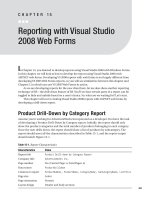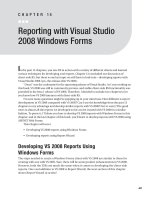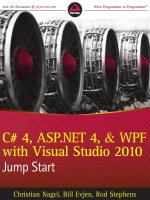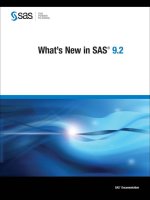Manning WPF in action with visual studio 2008 nov 2008 ISBN 1933988223 pdf
Bạn đang xem bản rút gọn của tài liệu. Xem và tải ngay bản đầy đủ của tài liệu tại đây (11.96 MB, 517 trang )
WPF in Action
with Visual Studio 2008
WPF in Action
with Visual Studio 2008
COVERS VISUAL STUDIO 2008 SP1 AND .NET 3.5 SP1
ARLEN FELDMAN
MAXX DAYMON
MANNING
Greenwich
(74° w. long.)
For online information and ordering of this and other Manning books, please visit
www.manning.com. The publisher offers discounts on this book when ordered in quantity.
For more information, please contact:
Special Sales Department
Manning Publications Co.
Sound View Court 3B Fax: (609) 877-8256
Greenwich, CT 06830 Email:
©2009 by Manning Publications Co. All rights reserved.
No part of this publication may be reproduced, stored in a retrieval system, or transmitted, in
any form or by means electronic, mechanical, photocopying, or otherwise, without prior written
permission of the publisher.
Many of the designations used by manufacturers and sellers to distinguish their products are
claimed as trademarks. Where those designations appear in the book, and Manning
Publications was aware of a trademark claim, the designations have been printed in initial caps
or all caps.
Recognizing the importance of preserving what has been written, it is Manning’s policy to have
the books we publish printed on acid-free paper, and we exert our best efforts to that end.
Recognizing also our responsibility to conserve the resources of our planet, Manning books are
printed on paper that is at least 15% recycled and processed elemental chlorine-free
Manning Publications Co.
Sound View Court 3B
Greenwich, CT 06830
Development Editor:
Copyeditor:
Typesetter:
Cover designer:
ISBN 1-933988-22-3
Printed in the United States of America
1 2 3 4 5 6 7 8 9 10 – MAL – 12 11 10 09 08
Jeff Bleiel
Andrea Kaucher
Dennis Dalinnik
Leslie Haimes
brief contents
PART 1
PART 2
PART 3
PAST, PRESENT, AND FUTURE .........................................1
1
■
The road to Avalon (WPF)
3
2
■
Getting started with WPF and Visual Studio 2008
3
■
WPF from 723 feet
22
41
THE BASICS .................................................................63
4
■
Working with layouts
65
5
■
The Grid panel
6
■
Resources, styles, control templates, and themes 119
7
■
Events
8
■
Oooh, shiny!
94
147
157
APPLICATION DEVELOPMENT .....................................177
9
■
Laying out a more complex application 179
10
■
Commands
11
■
Data binding with WPF
12
■
Advanced data templates and binding
191
v
209
253
vi
PART 4
BRIEF CONTENTS
13
■
Custom controls 299
14
■
Drawing
15
■
Drawing in 3D
315
352
THE LAST MILE ...................................................................... 371
16
■
Building a navigation application
17
■
WPF and browsers: XBAP, ClickOnce,
and Silverlight 390
18
■
Printing, documents, and XPS 406
19
■
Transition effects 427
20
■
Interoperability
21
■
Threading
474
457
373
contents
preface xvii
acknowledgments xix
about this book xxi
about the cover illustration xxv
PART 1 PAST, PRESENT, AND FUTURE ...............................1
1
The road to Avalon (WPF)
1.1
3
The past and the present
4
Why Windows drawing is the way it is 5 How we currently create
Windows UIs 7 Why the web is the way it is 9 How UI is
created on the web 10
■
■
1.2
Why Avalon/WPF
■
11
Taking advantage of modern hardware 12 Using modern
software design 13 Separating presentation logic from
presentation 14 Making it simpler to code GUIs 15
■
■
■
1.3
Creating UI using WPF 16
Defining WPF UI with XAML 16 Defining WPF UI through
code 17 Defining WPF UI with tools 18 Who does the
drawing 19 Pixels versus vectors 19
■
■
■
■
1.4
Summary
20
vii
viii
CONTENTS
2
Getting started with WPF and Visual Studio 2008 22
2.1
Your grandpa’s Hello, World!
23
Adding a button and button-handler to the window 25
Running Hello, World! 27 The TextBlock control 27
■
2.2
The application definition
30
Defining application startup in XAML 30
Why define the application in XAML? 31
2.3
A tour of WPF in Visual Studio 2008
34
The XAML designer 35 The Properties grid 38
Selection controls in Visual Studio 39 The Document
Outline 39
■
■
2.4
3
Summary
40
WPF from 723 feet 41
3.1
Where does WPF fit in Windows?
Red bits and green bits 42
3.2
Framework services
Base services
services 55
3.3
■
44
44 Media services 51
Document services 56
■
User interface
Necessary and useful tools 58
Microsoft Expression family
Other tools 60
3.4
Silverlight 43
■
■
42
Summary
59
■
Visual Studio
60
61
PART 2 THE BASICS .......................................................63
4
Working with layouts 65
4.1
4.2
The idea behind layout panels
The Canvas layout 68
66
Converting a Grid layout to a Canvas layout by modifying
the XAML 69 Adding a Canvas to an existing layout 69
Using attached properties 72 Setting up a Canvas
programmatically 73
■
■
4.3
The StackPanel layout 76
Adding scrolling support
80
■
The Expander control
81
ix
CONTENTS
4.4
The DockPanel layout
83
Defining a DockPanel in XAML
programmatically 85
4.5
4.6
5
Summary
Setting up a DockPanel
89
■
The FlowDocument 89
93
The Grid panel 94
5.1
Getting started with the Grid layout panel 95
Modifying the Grid
5.2
96
■
Grid specific properties
5.3
5.4
5.5
■
101
Laying out the calculator
102
The Grid and localization 107
UniformGrid 109
Making the calculator work 110
Handling operations
5.6
100
Using the Grid layout to build a calculator UI
Planning the calculator 101
Tweaking appearance 104
6
■
The WrapPanel layout 86
Other layout options 88
Specialized layout panels
4.7
84
Summary
110
Genericizing the handlers 114
■
117
Resources, styles, control templates, and themes 119
6.1
Resources
120
Using standalone resource dictionaries 122
from code 124 Dynamic resources 125
■
Using resources
■
6.2
Styles
131
Styles based on other styles
6.3
Control templates
133
Implicitly applying styles
■
135
136
Creating a control template 137 ContentPresenters 137
Template binding 138 Triggers 139
■
■
6.4
Themes
140
Using a specific theme
6.5
7
Summary
142
■
Changing themes from code
146
Events 147
7.1
Routed events
Bubbling events
148
149
■
Tunneling events 151
145
x
CONTENTS
7.2
Events from code 154
handledEventsToo
7.3
8
Summary
155
■
Class events 156
156
Oooh, shiny! 157
8.1
Glass buttons
158
Styling the text 162 Adding glow when over buttons 162
Handling the button click 164
■
8.2
Adding some simple animation 165
Animating button glow
8.3
8.4
8.5
165
■
Animating a color
168
Reflections 169
Transforms 173
Summary 174
PART 3 APPLICATION DEVELOPMENT ...........................177
9
Laying out a more complex application 179
9.1
9.2
Creating the Desktop Wiki Project
Nesting layouts 182
181
Preparing the layout for menus and toolbars 183
Adding menubars, statusbars, and toolbars… 184
9.3
Nested layouts
186
Adding the first Grid 187 Adding the second Grid 188
Using a StackPanel and Expander as navigation aids 189
■
9.4
10
Summary
190
Commands 191
10.1
A brief history of commands
192
Windows Forms and simple event handlers
Son of MFC 193
10.2
The WPF approach
The Command pattern
10.3
192
194
194
■
WPF commands
Using the built-in system commands
195
196
ApplicationCommands 197 NavigationCommands 198
EditingCommands 198 Component and media
commands 200
■
■
xi
CONTENTS
10.4
Handling commands
200
Handling a built-in command 200 Creating a custom
command 201 Shortcuts and gestures 202
■
■
10.5
10.6
Command routing 203
A cleaner custom command implementation
Implementing a RoutedUICommand
CommandBinding 206
10.7
11
Summary
204
■
204
Adding a
208
Data binding with WPF 209
11.1
11.2
WPF data binding 210
ProcessMonitor: A simple binding example
212
Binding Data with XAML 212 Binding in code 217
Binding notation and options 219
■
11.3
Binding to XML
223
Creating the CVE Viewer application 225 Binding controls
to XML 227 XPath binding notation 228 Path versus
XPath 229 Understanding and using DataContexts 230
Master-Detail Binding 233
■
■
■
■
11.4
Binding to ADO.NET database objects
234
Creating a bookmark utility 236 Creating the simple DAL
Laying out the UI and creating data bindings 238
■
11.5
Binding to business objects
242
Creating a WikiPage business object 242
ObservableCollection 243 Create a model façade
Wiring business objects to presentation objects 246
■
11.6
11.7
12
Binding to LINQ data
Summary 252
236
244
250
Advanced data templates and binding 253
12.1
Data converters 254
Formatting bound data with StringFormat 255 A number to
formatted string data converter 259 Converter parameters 261
■
■
12.2
12.3
DataTriggers 263
CollectionViewSource
266
Sorting with CollectionViewSource 266 Programatically sorting
with CollectionViewSource 268 Filtering with
CollectionViewSource 270
■
■
xii
CONTENTS
12.4
Conditional templates
273
A more involved template 273 Conditionally using
a template 275 Templates based on type 277
■
■
12.5
Validators
278
The ExceptionValidationRule 278 Custom
ErrorTemplates 280 Custom validation rules
■
■
12.6
12.7
Model-View-ViewModel 283
Advanced binding capabilities
Hierarchical binding 285
PriorityBinding 295
12.8
13
Summary
■
282
285
MultiBinding 289
298
Custom controls 299
13.1
Composing new user controls
301
Building a LinkLabel control 301
Testing the LinkLabel UserControl 304
13.2
Building custom controls
306
Building a control library 307 Create the new custom
control 308 Create the default template for the control 310
Testing the control 312 Customizing a custom control with
a template 313
■
■
■
13.3
14
Summary
314
Drawing 315
14.1
Drawing with Shapes
Shapes in XAML 317
14.2
317
■
Stupid shape tricks
Creating the graphing control
321
323
Building the GraphHolder control 323 Graphing using
shapes 327 Catching clicks 331 The downside
of Shapes 332
■
■
14.3
■
Drawing with direct rendering
Recreating the graph control
direct rendering 338
14.4
Drawing with Visuals
332
333
■
Pluses and minuses of
338
Control for display Visuals 339
Adding labels to our graph 344
■
Hit testing with Visuals
342
xiii
CONTENTS
14.5
Drawings and Geometries
GeometryDrawing
14.6
15
Summary
348
■
345
Using Drawings
349
351
Drawing in 3D 352
15.1
Lights, camera…
Models
15.2
15.3
354
■
353
Lights 357
Cameras 358
Graphing in 3D 359
3D Transforms 365
A 3D Transform in XAML
in code 366
15.4
■
Summary
366
■
A 3D Transform
369
PART 4 THE LAST MILE ................................................371
16
Building a navigation application 373
16.1
16.2
When and where to use navigation applications
Creating a basic navigation application 375
374
Adding some navigation 378 Implementing dictionary
lookup 379 Navigating programmatically 381
■
■
16.3
Page functions
384
Creating a Page function
16.4
17
Summary
384
■
Calling a page function
386
389
WPF and browsers: XBAP, ClickOnce, and Silverlight 390
17.1
Building an XBAP
391
XBAP security 394 Deploying an XBAP
When to use XBAP 399
■
17.2
Using ClickOnce
396
400
Deploying a WPF application via ClickOnce 401
When to use ClickOnce 402
17.3
17.4
Using Silverlight
Summary 405
403
xiv
CONTENTS
18
Printing, documents, and XPS 406
18.1
Printing flow documents
407
Setting up to print 408 Customizing the output
Printing asynchronously 413
■
18.2
411
Printing FixedDocuments 415
Adding some FlowDocument content to our FixedDocument
Matching resolution 420 Printing Visuals 421
417
■
18.3
XPS
422
Saving an XPS document to a file
with images… 424
18.4
19
Summary
422
The problem
■
426
Transition effects 427
19.1
Building the World Browser application 428
The DictionaryLookup class 428 Working with the Application
object 431 Our WorldListView user control 432
Populating the country list 433
■
■
19.2
19.3
Adding a simple transition 436
Building a generic transition control
439
Creating the transition control 439 Using the transition
control 442 Defining a ControlTemplate for our control 443
Using the ABSwitcher 445
■
■
19.4
Adding some interesting transition effects
The fade effect 446
for effects 453
19.5
20
Summary
■
Wipe effect 448
■
445
Adding a selector
454
Interoperability 457
20.1
Using Windows Forms controls in WPF
458
Using the Windows Forms DateTimePicker in WPF 458
Enabling Windows themes for Windows Forms control 461
What you can’t do with embedded Windows Forms controls 462
Using your own Windows Forms controls 463 Popping up
Windows Forms dialogs 464
■
20.2
Embedding ActiveX and C++ in WPF
Embedding ActiveX controls in WPF
controls in WPF 468
466
466
■
Embedding C++
xv
CONTENTS
20.3
Using WPF in Windows Forms
469
Using a WPF control inside of Windows Forms
WPF dialogs 472
20.4
21
Summary
469
■
Popping up
473
Threading 474
21.1
21.2
21.3
21.4
Moving slow work into a background thread 476
Asynchronous calls 479
Timers 480
Summary 481
index
483
preface
A number of years ago, the two of us worked at the same company and had to design a
new form definition language for an entirely definitionally-driven system. The definitions were to be stored in XML. They had to be loosely bound to data definitions, and
allow for complex behavior changes based on data. The individual elements of a form
had their own properties, but also had to store properties that they didn’t care about
but that were relevant to higher-level layout mechanisms. We built this long before
WPF was even a glimmer of a concept at Microsoft.
We’d like to pretend that Microsoft saw our brilliant design and decided to copy it
when creating WPF, but that would be a lie, and we only lie when we’re fairly sure that
our facts can’t be verified elsewhere.
Nonetheless, WPF does encapsulate all the basic design principles that we had for
our form definition language, and then goes soaring off to leave our pitiful efforts in
the dust. When we first started playing around with (extremely) early versions of what
was then called Avalon, we had a lot of “duh, why didn’t we do it that way” moments as
well as, to be kind to our battered egos, a few “yeah, that’s how we did it” moments.
We’re both extremely comfortable in the Windows Forms (and the Windows SDK)
world, so moving to WPF was both a happy and sad experience—sad in that we watched
a lot of our hard-won knowledge become obsolete, but happy in that WPF made us way
more productive, and let us do things quickly and easily that we would have just skipped
with Windows Forms because they would have taken entirely too much effort.
Not that everything was a bowl of things that you like to keep in bowls—particularly with early betas and lack of documentation; we definitely spent time whining and
xvii
xviii
PREFACE
banging our heads into walls. Overall, though, we are pretty happy with WPF, and are
looking forward to where it’s going to go in the future.
Fast forward a year or two, and one of us foolishly answered a phone call from
Mike Stephens at Manning, asking about a completely different project. After many
abject refusals, the conversation turned to WPF and the fact that there weren’t many/
any books out there that covered both WPF and Visual Studio 2008. Some slightly less
abject refusals later, we suddenly discovered that we’d signed a contract to produce
said book and have it ready in time for the release of Visual Studio 2008.
The astute reader might check when VS 2008 came out and the published date on
this book and realize that we didn’t quite make our original deadline. But, rather than
laziness on our part, this really speaks to our timing genius—we managed to completely revise the book to take into account the many changes in Visual Studio 2008
SP1, which was released not long before these words were typed.
The goal of this book is to provide a practical guide to building WPF applications
using Visual Studio 2008 SP1. It isn’t intended to replace the MSDN reference material, but to provide guidance on how to get started and what you need to know to be
productive in WPF. Productive is a relative term, of course—WPF has a lot of cool capabilities that can enhance your apps in many ways—and suck up all your available time
with tweaking. It’s up to you whether you can really ship your application without that
flaming drop-shadow…
acknowledgments
This book wouldn’t exist if it were not for a conversation many months (years?
decades?) ago with Mike Stephens at Manning on an entirely different topic. Whether
this warrants thanks or not remains to be seen, but we do have to thank him for being
a great person to work with and for being incredibly patient with us as we watched
deadlines sail majestically by (and for having a great sense of humor).
We also have to thank our fantastic editor Jeff Bleiel, and our original editor
Douglas Pundick who left for reasons entirely unrelated to us (we hope). Also, thanks
to the rest of the production team at Manning: Andrea Kaucher, Mary Piergies,
Maureen Spencer, Karen Tegtmeyer, Dennis Dalinnik, Dottie Marsico, Tiffany Taylor,
Leslie Haimes, Gabriel Dobrescu, and Ron Tomich.
We’d like to thank these reviewers for their valuable feedback on the manuscript
during the various stages of development. Their insights and comments helped make
it much, much better: Tim Sneath, Beatriz Costa, Patrick Long, Lester Lobo, Don
Burnett, Andrew Konkol, Alessandro Gallo, Bryce Darling, Frank LaVigne, Nishant
Sivakumar, Rama Krishna Vavilala, Barry Elzel, Joe Stagner, Ben Constable, David
Barkol, Cal Schrotenboer, Oliver Sturm, Scott Pugh, Nick Kramer, Scott Baldwin, Dave
Corun, Mark Mrachek, Riccardo Audano, Darren Neimke, Jeff Maurone, Michael
Feathers, Doug Warren, Radhakrishna M.V., Jon Skeet, Tomas Restrepo, Berndt
Hamboek, Aleksey Nudelman, Andrew Stopford, John Price, and Curt Christianson.
We also have to thank the legion of reviewers who took the time to review early versions of the manuscript on the Manning Author Online forum and who helped test
drive the code. A big shout-out also goes to the WPF blogging community who were
xix
xx
ACKNOWLEDGMENTS
running into and through issues that had us stymied, and who gave us a number of
ideas and insights.
At Microsoft, we have to first thank Luke Hoban, who was not only willing to
answer irritating questions but also to bother all sorts of other people on our behalf
to answer irritating questions. Thanks also to Mark Boulter, The Program Manager/
Tech Lead on the .NET Client Team, for answering pages of questions while trying to
get not one but two massive products out the door. Sam Bent on the data binding team
spent several days confirming that we had hit real bugs, and were not insane. Well, not
just insane. Charlie Calvert and Kevin Moore also gave us a hand, which we appreciate.
In the category of blatant friend abuse, we have to thank our blog-compatriot at
www.exotribe.com, Tim Binkley-Jones, for being a sounding board and for eventually
ending up doing our technical review, as well as David Russell for general guinea-pig
services (and who probably now knows more about WPF than either of us. Sigh).
We also have to thank our wives—Tami Wandell and Adriana Wood—for not murdering either of us in our sleep, an act which would have been entirely warranted.
Finally, we would like to thank Microsoft for creating WPF—without which this book
would have been a lot more confusing, and much less likely to have been published.
about this book
This book is designed to give you a working knowledge of Windows Presentation
Foundation (WPF). The assumption is that the reader is already a .NET developer with
some familiarity with other UI technologies (WinForms, MFC, HTML) but is new to
WPF. In particular, the book focuses on using WPF with Visual Studio 2008, which we
believe is the primary tool that most WPF developers will use, although we still spend
some time talking about other available tools.
Throughout the book, your authors have injected some measure of their twisted
humor, and have been known, on occasion, to resort to irony and sarcasm. We truly
love WPF, but we also try not to take anything too seriously—and we hope that it makes
reading yet another technical book just that little bit less gnaw-your-own-leg-off boring.
Roadmap
This book is broken down into four main parts. Part 1 is mostly about history and
overviews. Chapter 1 starts this off by explaining how drawing in Windows and on the
web got to where they are today, and the general way in which WPF addresses some
existing problems. Chapter 2 is the first chance to get your feet wet with some simple
WPF code, and also provides a guided tour of WPF-specific features of Visual Studio
2008. Chapter 3 provides a reasonably detailed look at what WPF is made of, as well as
various surrounding technologies and acronyms that are likely to cross your path.
Part 2 covers the core concepts and technologies of WPF, primarily through an
extremely brilliantly thought-out example application (OK, OK, a calculator). Chapter 4
is all about layouts and the general laying out of content in WPF. In chapter 5, we
xxi
xxii
ABOUT THIS BOOK
introduce the most complex of the layouts—the Grid—and use it to rough in the calculator example. Chapter 6 demonstrates how to control the look of an application via
the use of resources, control templates, and themes. In chapter 7, we cover the new
eventing model of WPF. Finally, in chapter 8, we pull out all the stops to make the calculator sexy and demonstrate some of the hotness that is WPF.
Part 3 focuses on building real-world applications. In chapter 9, we show how to
build the framework for a complex application, including menus and toolbars. Chapter 10 demonstrates WPF command routing. Chapter 11 shows how to hook up data to
WPF applications via data binding, including pulling data from databases, XML, or
objects in general. Chapter 12 continues the binding conversation with more
advanced types of binding and with the use of data templates to control the way data is
handled. We also explain the new Model-View-ViewModel pattern.
Chapter 13 is about building custom controls in WPF—either one-off combinations
of controls, or standalone controls designed to be distributed. In chapter 14, we demonstrate various ways of doing drawing in WPF, and in chapter 15, the last chapter of
part 3, we extend that to the third dimension.
Part 4 covers some additional topics likely to be relevant to developing WPF apps.
Chapter 16 demonstrates building navigation applications—apps with back/forward
and hyperlinking support, which is built into WPF. In chapter 17, we take the navigation application and demonstrate how it can be hosted inside a browser via the use of
XBAP. We also demonstrate ClickOnce deployment with a WPF application and touch
(briefly) on Silverlight—a third way in which WPF can take to the web.
Chapter 18 is all about printing and documents. WPF has extensive support for
printing and for transferring content around via XPS. In chapter 19, we take a break
from the boring stuff and demonstrate how to add slick transitions to your applications. We also talk a fair amount about designing an application to support effects.
Chapter 20 is about using other stuff with WPF, such as Windows Forms and WPF, and
using WPF with Windows Forms. Finally, chapter 21 covers threading, including the
new WPF Dispatcher, and timers.
Throughout the text, we’ve also sprinkled various tips and nags on WPF, UI design,
and whatever else we felt like at the time. The book is generally designed to be read
from start to finish, but you can certainly jump around to different topics and use the
various chapters for reference as needed.
Code
This book contains a number of examples written in C# and/or in XAML. Although we
did most of the work using the Professional version of Visual Studio 2008, you can do
almost everything here using Visual Studio 2008 Express, which can be downloaded
for free from Microsoft at www.microsoft.com/express. We’ve tried to indicate when
particular capabilities require one of the for-money versions. All the source code for
the book (and a few additional examples) can be downloaded from www.manning.
com/WPFinAction or from our blog at www.exotribe.com.
ABOUT THIS BOOK
xxiii
The following conventions are used throughout the book:
■
■
Courier typeface is used to denote code samples, as well as elements and
attributes, method names, classes, interfaces, and other identifiers.
Code annotations accompany many segments of code. Certain annotations are
marked with bullets such as b. These annotations have further explanations
that follow the code.
Author Online
The purchase of WPF in Action with Visual Studio 2008 includes free access to a private
forum run by Manning Publications where you can make comments about the book,
ask technical questions, and receive help from the authors and other users. You can
access and subscribe to the forum at www.manning.com/WPFinAction. This page provides information on how to get on the forum once you are registered, what kind of
help is available, and the rules of conduct in the forum.
Manning’s commitment to our readers is to provide a venue where a meaningful
dialogue among individual readers and between readers and authors can take place. It
isn’t a commitment to any specific amount of participation on the part of the authors,
whose contributions to the book’s forum remain voluntary (and unpaid). We suggest
you try asking the authors some challenging questions, lest their interests stray!
The Author Online forum and the archives of previous discussions will be accessible from the publisher’s website as long as the book is in print.
There are a number of good WPF resources out on the web, including:
■
■
■
■
■
The authors’ blog, which covers a number of topics (including WPF), at www.
exotribe.com
Microsoft’s windowsclient.net, which is a good place for general WPF (and WinForms) articles
The WPF team blog at wpf.netfx3.com/blogs/presentation_bloggers
The blog of Tim Sneath, a Technical Evangelist at Microsoft and the creator of
the famed WPF New York Times Reader, at />Beatriz Costa’s blog, which is the place to go for data binding info, at www.
beacosta.com/blog
About the authors
ARLEN FELDMAN has been developing software professionally for over 20 years, and
has been a Windows developer for the last 14. He was chief architect for the awardwinning HEAT software product, and has been working with .NET since its earliest
days, including working with Microsoft on the direction of .NET, the C# language, and
Visual Studio, as a member of the C# customer council. Arlen specializes in architecting and building metadata-driven applications, particularly focusing on the usability
issues of such systems. Because of an accident involving rogue metadata retrieval, his
brain is now a five-dimensional hyper-cube.
xxiv
ABOUT THIS BOOK
Arlen is the author of ADO.NET Programming (Manning, 2003), and is currently the
Chief Architect for Cherwell Software, builders of .NET-based support solutions. He
lives in Colorado Springs, Colorado.
MAXX DAYMON learned BASIC (on a Commodore VIC-20) before he learned English.
His extremely eclectic background has given him experience with virtually every type
of personal computer and a whole host of different industries; he’s considered an
expert in the back-end to the front-end of application design. To say that he’s somewhat obsessed with human factors engineering would be like saying that Ghengis
Kahn kind of liked fuzzy hats.
Maxx is MCPD Certified for both Windows and web development, and has been
working with .NET since its preview releases. Maxx is currently a Software Architect at Configuresoft, a leading developer of configuration-management and compliance software.
About the title
By combining introductions, overviews, and how-to examples, the In Action books are
designed to help learning and remembering. According to research in cognitive science, the things people remember are things they discover during self-motivated
exploration.
Although no one at Manning is a cognitive scientist, we’re convinced that, for
learning to become permanent, it must pass through stages of exploration, play, and,
interestingly, retelling of what is being learned. People understand and remember new
things, which is to say they master them, only after actively exploring them. Humans
learn in action. An essential part of an In Action book is that it’s example-driven. It
encourages the reader to try things out, to play with new code, and explore new ideas.
There is another, more mundane, reason for the title of this book: our readers are
busy. They use books to do a job or solve a problem. They need books that allow them
to jump in and jump out easily and learn just what they want just when they want it.
They need books that aid them in action. The books in this series are designed for
such readers.









